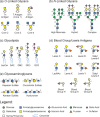Perspectives on Anti-Glycan Antibodies Gleaned from Development of a Community Resource Database
- PMID: 27220698
- PMCID: PMC4949583
- DOI: 10.1021/acschembio.6b00244
Perspectives on Anti-Glycan Antibodies Gleaned from Development of a Community Resource Database
Abstract
Antibodies are used extensively for a wide range of basic research and clinical applications. While an abundant and diverse collection of antibodies to protein antigens have been developed, good monoclonal antibodies to carbohydrates are much less common. Moreover, it can be difficult to determine if a particular antibody has the appropriate specificity, which antibody is best suited for a given application, and where to obtain that antibody. Herein, we provide an overview of the current state of the field, discuss challenges for selecting and using antiglycan antibodies, and summarize deficiencies in the existing repertoire of antiglycan antibodies. This perspective was enabled by collecting information from publications, databases, and commercial entities and assembling it into a single database, referred to as the Database of Anti-Glycan Reagents (DAGR). DAGR is a publicly available, comprehensive resource for anticarbohydrate antibodies, their applications, availability, and quality.
Conflict of interest statement
The authors declare no competing financial interest.
Figures






References
-
- (2012) In Transforming Glycoscience: A Roadmap for the Future, National Academies Press, Washington, DC. - PubMed
-
- Bertozzi C. R., and Rabuka D. (2009) Structural Basis of Glycan Diversity, in Essentials of Glycobiology (Varki A., Cummings R. D., Esko J. D., Freeze H. H., Stanley P., Bertozzi C. R., Hart G. W., and Etzler M. E., Eds.), 2nd ed., Cold Spring Harbor, New York. - PubMed
-
- Feizi T.; Childs R. A. (1985) Carbohydrate structures of glycoproteins and glycolipids as differentiation antigens, tumor-associated antigens and components of receptor systems. Trends Biochem. Sci. 10, 24–29. 10.1016/0968-0004(85)90012-X. - DOI
Publication types
MeSH terms
Substances
LinkOut - more resources
Full Text Sources
Other Literature Sources

